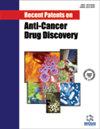针对铁下垂作为辐射防护和缓解的新途径
IF 4.1
4区 医学
Q3 ONCOLOGY
Recent patents on anti-cancer drug discovery
Pub Date : 2023-01-19
DOI:10.2174/1574892818666230119153247
引用次数: 0
摘要
放射诱导的正常细胞毒性(RINCT)是放射治疗任何疾病时需要考虑的主要因素。肿瘤的临床照射需要了解辐射保护剂在减少对健康组织的辐射损伤方面的潜在功效及其对肿瘤组织放射敏感性的影响。脱铁症是一种相对较新的铁依赖性细胞死亡形式,与多种疾病病理有关。脱铁性贫血的主要介质是脂质过氧化和铁代谢。脂质过氧化是活性氧(ROS)和活性氮(RNS)与含有磷脂酰乙醇胺的多不饱和脂肪酸(PUFA)反应的结果。Ferroptosis抑制剂已被证明在疾病动物模型中具有抗炎作用。最近的研究表明,电离辐射(IR)会产生严重的脱铁性贫血,这是RT介导的正常细胞毒性的关键组成部分。这些发现支持使用脱铁抑制剂治疗辐射正常细胞毒性。靶向脂质代谢底物并通过辐射控制脱铁性贫血可以降低毒性并改善临床结果。在这项研究中,我们讨论了放射治疗与各种类型的辐射诱导的细胞死亡之间的关系,我们还讨论了脱铁性贫血与放射治疗产生的其他类型的控制性细胞死亡的相互作用,并研究了放射治疗中针对脱铁性肺病的联合治疗方案。这篇综述将为今后放射治疗脱铁性贫血的研究奠定基础。此外,还讨论了具有各种治疗潜力的脱铁性贫血抑制剂的相关专利。本文章由计算机程序翻译,如有差异,请以英文原文为准。
Targeting ferroptosis as a new approach for radiation protection and mitigation
Radiation-induced normal cell toxicity (RINCT) is a major factor to consider while treating any ailment with radiotherapy. Clinical irradiation of tumors necessitates an understanding of the potential efficacy of radiation protective agents in reducing radiation damage to healthy tissues and their effects on tumor tissue radiosensitivity. Ferroptosis is a relatively new form of iron-dependent cell death that has been linked to a variety of disease pathologies. The key mediators of ferroptosis have been identified as lipid peroxidation and iron metabolism. Lipid peroxidation is the result of a reaction between reactive oxygen (ROS) and reactive nitrogen species (RNS) with phosphatidylethanolamine-containing polyunsaturated fatty acids (PUFAs). Ferroptosis inhibitors have been demonstrated to have anti-inflammatory effects in animal models of disease. It was recently shown that ionizing radiation (IR) generates severe ferroptosis, a critical component of RT-mediated normal cell toxicity. These findings support the use of ferroptosis inhibitor treatments for the treatment of radiation normal cell toxicity. Targeting lipid metabolic substrates and controlling ferroptosis by radiation could reduce toxicity and improve clinical outcomes. In this study, we address the relationships between radiotherapy and various types of radiation-induced cell death, and we discuss the interactions between ferroptosis and other kinds of controlled cell death generated by radiotherapy, and we investigate combination treatment options targeting ferroptosis in radiotherapy. This review will be a foundation for future research on ferroptosis in radiotherapy. Additionally, the relevant patents on ferroptosis inhibitors with various therapeutic potentials have been discussed.
求助全文
通过发布文献求助,成功后即可免费获取论文全文。
去求助
来源期刊
CiteScore
4.50
自引率
7.10%
发文量
55
审稿时长
3 months
期刊介绍:
Aims & Scope
Recent Patents on Anti-Cancer Drug Discovery publishes review and research articles that reflect or deal with studies in relation to a patent, application of reported patents in a study, discussion of comparison of results regarding application of a given patent, etc., and also guest edited thematic issues on recent patents in the field of anti-cancer drug discovery e.g. on novel bioactive compounds, analogs, targets & predictive biomarkers & drug efficacy biomarkers. The journal also publishes book reviews of eBooks and books on anti-cancer drug discovery. A selection of important and recent patents on anti-cancer drug discovery is also included in the journal. The journal is essential reading for all researchers involved in anti-cancer drug design and discovery. The journal also covers recent research (where patents have been registered) in fast emerging therapeutic areas/targets & therapeutic agents related to anti-cancer drug discovery.

 求助内容:
求助内容: 应助结果提醒方式:
应助结果提醒方式:


